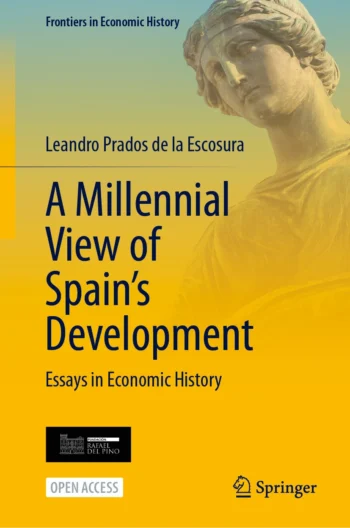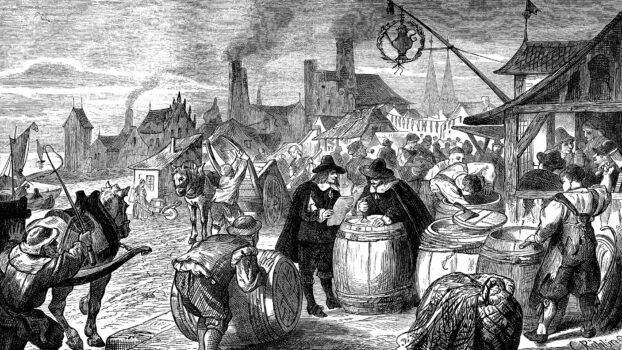This section contains historical series of the Spanish economy resulting from research conducted by Professor Leandro Prados de la Escosura. The format in which the data are presented, along with the tools provided for their analysis in this space, enables users to gain a deeper understanding of our economic history and navigate through the various periods of expansion and crisis that the Spanish economy has experienced since the mid-19th century. It also offers a comparative view of GDP and population since the late 13th century.
The database developed by Professor Prados de la Escosura provides up-to-date historical national accounts - including estimates of GDP, both on the demand and supply side, as well as of capital, labour and total factor productivity - a statistical basis of undoubted value for investigating the long-term evolution of Spanish economic activity. It includes
- GDP: Expenditure and Output, 1850-2023
- Capital Stock and Services, 1850-2023
- Growth Accounting, 1850-2023
- GDP and Population, 1277-1850
- Per Capita GDP, 1277-2023: International Comparisons
The new database shown below revises and expands to the present day the estimates offered in
Prados de la Escosura, L. (2017), Spanish Economic Growth, 1850-2015Palgrave Macmillan. Available in Open Access at: https://link.springer.com/book/10.1007/978-3-319-58042-5
Prados de la Escosura, L. (2024), A Millennial View of Spain's Development. Essays in Economic HistorySpringer. Available in Open Access at: https://link.springer.com/book/10.1007/978-3-031-60792-9
Graphics:
The following is a visualisation tool for the main historical series from offer y demand of this new base, as well as the international comparison of GDP per capita since 1850. In addition, the evolution of the GDP per capita in the Pre-industrial Spain 1277-1850.
Technical information:
Series construction
Historical output and expenditure series have been reconstructed for the century before the advent of modern national accounting.

In addition, the series corresponding to the different national accounts bases have been linked by interpolation (as an alternative to the conventional backwardpolation method). Finally, the series of the "pre-statistical era" (1850-1958) have been spliced with those resulting from the national accounts linkage, including the Statistical Review 2020, in order to obtain annual series of GDP and its expenditure and output components. since 1850.
The database includes nominal (at current prices) and real or volume (at constant prices) series of GDP and its expenditure and output components. It also provides nominal and real estimates of Gross National Income (GNI), Net National Income (NNI) and Net National Disposable Income (NNDI). Deflators (implicit price indices resulting from dividing the nominal series by the volume series) are also provided for GDP and its demand and supply components (expenditure and output), as well as for GNI, NNI and NNDI. On the basis of new population estimates, GDP per capita has been derived.
Estimates of labour productivity, calculated from Gross Value Added (GVA) and new series of full-time equivalent (FTE) employment and hours worked, are presented.
Finally, PPP-adjusted GDP per capita - i.e. adjusted for international differences in the price level (purchasing power parity, PPP) - is placed in comparative perspective (expressed in 2011 GEKS and 1990 Geary-Khamis dollars, respectively).
Gross Domestic Product (GDP) is the value at market prices of all final goods and services produced in a country during a given period.
GDP on the expenditure side is total final expenditure a market prices (including the value of exports of goods and services) minus the value of imports of goods and services.
The GDP on the expenditure side equals private final consumption + public final consumption + gross capital formation + exports - imports.
GDP on the output side is the sum of the gross value added of the different sectors at the end of the year. basic pricesplus net taxes on products///all taxes, less subsidies, on products.
The Gross Value Added (GVA) is defined as the value of all new goods and services generated minus the value of all goods and services consumed since their creation; it does not include depreciation of fixed assets.
The basic prices is the amount received by the producer excluding taxes paid on the products and including subsidies received for the products.
The Nominal GDP which is the value of GDP at current prices. Here it is expressed in millions of euros.
The Real GDP which is the value of GDP at prices in a given year. Here it is expressed in millions of 2010 euros.
The use of series of GDP at constant pricesThe change in the price level, rather than at current prices, removes the impact of price changes and shows the change in the volume of GDP.
The GDP deflator is the price index that measures changes in the aggregate price level of the goods and services that make up GDP. It is obtained as the ratio of nominal to real GDP and is expressed as an index with 2010=100.
The Gross National Income at market prices (GNI) is the sum of the incomes of residents in an economy over a given period. It is equivalent to the GDP minus net primary income from the rest of the world.
Note that the Gross National Income (GNI) is identical to the Gross National Product (GNP)
Net National Income at market prices (NNI) is equivalent to the GNI minus consumption of fixed capital.
Consumption of fixed capital reflects the decline in the value of fixed assets of businesses, the state and homeowners in the household sector.
Net National Disposable Income at market prices (NNDI) is equivalent to the RNN plus net current transfers from the rest of the world.
The Nominal (or real) GDP per capita per capita is the average GDP per person and is calculated by dividing the nominal (or real) GDP of a given year by the population of that year.
The labour productivity measures the quantity of goods and services produced per labour input.
Here labour productivity is defined as the Gross Value Added (GVA) per full-time equivalent worker (ETC) or per hour worked. It is expressed as an index with 2010=100.
Employment represents the number of persons engaged in productive activities in an economy, including employees and the self-employed.
The number of full-time employees (FTE) is obtained by dividing the total number of hours worked per year by the hours worked by a full-time employee in the same year.
PPP-adjusted GDP per capita represents GDP per person adjusted for differences in price levels across countries (purchasing power parity adjustment, PPP). Here it is expressed alternatively in 2011 EKS dollars and 1990 Geary-Khamis dollars in order to facilitate international comparisons.
PPPs report how many monetary units a given quantity of goods and services costs in different countries.
Bibliographical references
BBVA Foundation: The Economic Progress of Spain, 1850-2000 (Prados de la Escosura, 2003)
Springer: Spanish Economic Growth, 1850 - 2015 (Prados de la Escosura, 2017) (series updated to 2020).
Springer: A Millennial View of Spain's Development (Prados de la Escosura, 2024)
External links
📖 VOX EU: A long-run perspective on the productivity slowdown: Spain since 1850
📖 VOX EU: Growth recurring in a pre-industrial economy: Spain in a half-millennium perspective
📖 Nothing is Free: The productivity slowdown in Spain: a long-term view
📖 Warwick: The Black Death in Spain: A European Perspective
📖 Springer Link: Capital in Spain, 1850-2019
📖 Wiley online library: Accounting for Growth: Spain, 1850-2019
📖 Springer Link: Growth recurring in pre-industrial Spain?
📖 Wiley Online Library: Accounting for Growth in History
📖 Science Direct: War, pandemics, and modern economic growth in Europe
📖 Springer Link: Subjective well-being and inequality in Spain's decline
📖 Economic History Research: A Millennial View of Spain's Development. Essays in Economic History (Leonardo Ridolfi)
📺 Restlessness: Medieval Spain (Video)
🎧 Restlessness: Leandro Prados de la Escosura (Audio)
📺/🎧 From frontier to empire: an economic history of Spain (Video / Audio)
📺/🎧 From empire to nation: an economic history of Spain over the last 200 years (Video / Audio)
Interview in TODO COMENZÓ AYER, the informative podcast of the Spanish Association of Economic History, on the occasion of the publication: A Millennial View of Spain's Development: Essays in Economic History
🎧 SPOTIFY: https://open.spotify.com/episode/0hy3YtlEVfIX4fHEpULOIe
🎧 IVOOX: https://www.ivoox.com/episodio-76-a-millennial-view-of-spain-s-audios-mp3_rf_150490721_1.html
🎧 APPLE PODCASTS: https://podcasts.apple.com/es/podcast/episodio-76-a-millennial-view-of-spains/id1549178293?i=1000713387211
Spanish Historical Macroeconomic Series by Leandro Prados de la Escosura is licensed under CC BY 4.0










